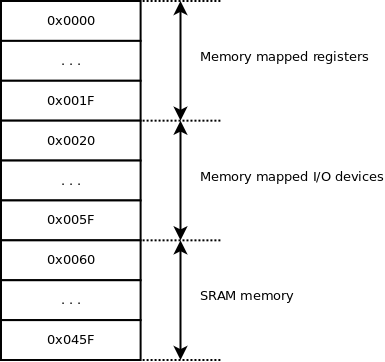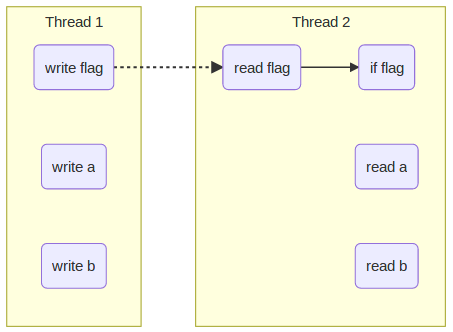C++11 volatile
A brief history of the meaning of volatile in C++
Original purpose for memory mapped I/O
Traditionally the key word volatile in C, was meant to be used in a specific
scenario where devices map I/O devices into memory.
For example in the figure below, a fictional device would document the layout of it’s memory space such that only some of that is backed by actual RAM. Other regions have different purposes. In particular this sample shows that a range of addresses reserved for I/O mapped devices.

A complete documentation for such a device would detail the behaviour for each
address reserved for I/O device and it’s side effects. Some locations are
intended as write only (for output devices), others read only (for input
devices), and others for both read and write. For example writing at a
particular address would actually send data over the serial port. So writing to
a memory address using assembly instructions like MOV (for move) or ST
(for store) could, depending on the actual address, either write a value to RAM
or send data over the serial port.
The C compiler would generate reads or writes to memory addresses for
assignments to volatile qualified variables, instead of optimising them
away.
In the example where we want to write two bytes over the serial port we would
have two assignments to a variable qualified by volatile, and we want the
compiler to generate two write assembly instructions instead of optimising and
only writing the second value just once.
In this context the relative order of access is important. E.g. one could write to a I/O memory mapped location to enable the serial port, then write to another location to send a byte, if the compiler changes the order the net effect in this case would be no data sent.
The C compiler would preserve the order of assignments to volatile qualified
variables, ensuring they are not reordered.
Extending the patters of usage
The volatile keyword was then used in other languages: C++ obviously, but also
Java and C#. At the same time multi-threading became popular. And issues were
discovered where programmers were encouraged by books, vendor documentation
etc. to use the volatile keyword to fix threading issues, outside it’s
original purpose of dealing with memory-mapped I/O.
For example, in a produced-consumer pattern, a producer thread sends some data
to a consumer thread and they use a flag to agree on when the data was send.
In the code below, the producer thread writes two variables a and b, then
sets a flag and a consumer thread waits in a loop for the flag to be set
before reading a and b.
1
2
3
4
5
6
7
8
9
10
11
12
13
14
15
16
17
18
19
20
int a = 0;
int b = 0;
bool flag = false;
void producer_thread()
{
// write a and b
a = 42;
b = 43;
// set the flag at the end
flag = true;
}
void consumer_thread()
{
// wait for the flag to be set
while (!flag) continue;
// the flag was set: use a and b
...
}
Sometimes this code would appear to work.
But other times, the compiler would look at the consumer wait loop and notice
that, inside it, the value of the flag is not tested, therefore it would read
the value of the flag once, and if not set, wait forever in a while (true)
loop. When this happened, it was reasonably obvious: the consumer thread would
loop forever. Qualifying the flag as volatile was recommended as a pattern in
these situation to ensure that the compiler will retry the read of the flag
and exit the wait loop when the flag is eventually set.
Reordering around volatile
Qualifying the flag as volatile solves the problem that the consumer thread
reads the value of the flag repeatedly until set, but issues that were more
subtle continued to exist and they took longer to be understood.
The programmer’s intention is to also have guarantees that:
- the writes to
aandbprecede setting theflag - the reads from
aandbfollow reading theflag(if set)
These expectations look more like the graph shown by the solid arrow lines in the diagram below:

But while the original guarantees for volatile promised that the order of
assignments to volatile qualified variable is preserved, it does not mean
that no reordering will happen around volatile assignments.
In our example, it does not enforce any ordering with regards to a and b
which are not marked as volatile. The compiler will actually generate a
dependency graph shown by the solid arrow lines in the diagram below:

That meant that sometimes a and b were written after the flag was set,
and the consumer thread would see incorrect values. These issues were more
difficult to understand and fix.
Java and C#
Over time it became clear that programming languages need to define a memory model that must provide guarantees to fix multi-threading problems by, among other things, inserting appropriate memory fences (explicit or implicit).
Java was the first to clarify its memory model in JSR 133, for
Java 5 (also known as Java 1.5), around 2004. With regards to the volatile
keyword it chose to ensure that it’s atomic, that it also adds full memory
fences.
This approach has the advantage that popular solutions to multi-threading issues like the producer-consumer scenario above, but also others, like the double-checked locking, were working now.
C# followed the suit. For example it’s specification for volatile mentions:
A read of a volatile field is called a volatile read. A volatile read has “acquire semantics”; that is, it is guaranteed to occur prior to any references to memory that occur after it in the instruction sequence
C++11
A memory model was added to the C++11 standard to support multi-threading. But
in C++ the decision was to keep the keyword volatile as a mean to solve the
original memory mapped I/O problems. In C++11 volatile does not guarantee
memory barriers for non-volatile access.
For multi-threaded problems as above, low level available operations are meant to be addressed by atomics (which are quite fine grained, at least in theory).
Some legacy code still relies on previous guidance for volatile. Microsoft
provided such guidance, and after some confusion, they decided to have two
mode of operation:
/volatile:mswhich is more akin the Java approach of providing full memory barriers, enabled by default on x86 platforms/volatile:isowhich abides the C++ standard behaviour
My recommendation is for new C++ code is to not use volatile to address
multi-threading issues.
That’s not the end of it
For example, for a processor similar to the one described in the fictional example above, the programmer intends to assign to a 16-bit variable. The processor is 8-bit, the assignment is not atomic, an interrupt could see only half of the value, unless interrupts are disabled while the assignment instructions are performed. The value is also the result of a calculation. Sample code looks like this:
1
2
3
4
5
6
7
void fn(unsigned int value)
{
value = 65535U / value; // calculation
cli(); // disable interrupts (cli = clear interrupt)
global_variable = value; // assignment
sei(); // enable interrupts (sei = set interrupt)
}
The real example has additional complexity. For example cli() and
sei() are implemented as assembly instructions. But in summary, using
techniques equivalent to using volatile as a qualifier, the best dependency
graph that can be generated looks like below:

The problem is that the calculation can be reordered by the compiler inside the region where the interrupts are disabled. On that processor, performing a division can take a long time; interrupts can’t be served. This has implications on the duration for which interrupts can’t be served, changing the real-time characteristics of the system.
This kind of timing problem is not fixable given the current threading support
or current meaning of volatile, and it’s not limited to the processor in the
example.
Conclusion
The understanding and meaning of the volatile keyword evolved and changed
over time, which might even end up having it deprecated. This article is a just
a brief introduction, for the precise meaning, limits and guarantees in a
specific programming language and dialect/version/vendor check the official
documentation of the language.
References
- Jeremy Manson and Brian Goetz: JSR 133 (Java Memory Model) FAQ, February 2004
- C# language specification on volatile
- MSDN in Visual Studio 2019: volatile (C++), 7 May 2019
- Jan Waclawek: Problems with reordering code
- JF Bastien: Deprecating volatile, CppCon 2019, 19 Oct 2019